Summary, abstracts and full texts of issue no. 111
Philippe Mesnard (Editor in chief): Editorial: Voyages mémoriels en question (pdf in French) (pdf in Dutch) [Questions concerning visits to memorial sites]
Dossier: Dangerous game between Art and Propaganda
Edited by Luba Jurgenson and Philippe Mesnard
Luba Jurgenson and Philippe Mesnard: Présentation (pdf)
Iveta Slavkova (HAR, Paris-Ouest-Nanterre-La Défense University): Le futurisme entre propagande et revendication libertaire (pdf) [Futurism between propaganda and demands for freedom]
- The vital futuristic project is a political project that aims to transform society through the creation of a new man (Superuomo) strong, domineering, industrial, and urban. The Futurists want to persuade everyone of the legitimacy of their proposals and they are exerting a lot of effort through the use of words and images, to achieve their goal. Therefore, it is not surprising to find similarities between these futuristic images and those employed in propaganda: the use of stereotypes, heroes, to rally emotional support rather than a profound analysis of political and social realities.
Through a few selected images, we will focus on the visual strategy of the futurists, aggressive and innovative, which aims to “sollicit” and pay tribute to the audience. We will notice that the form that appears as free and open is actually carrying a binding and homogenizing message. This rhetoric is also found in the very definition of the futuristic new man who wants to be free, but is actually predetermined, who wants to be multifaceted all the while remaining molar.
Thus, this reflection on futurism will allow us to question the limits and ambiguities of the universal assertions and the certainty of serving universal values that we also observe in propaganda images. Are the Futurists, in essence, purposely misusing universalism and universal values? Or conversely, do they express the essence of universalism that requires a constraining homogenization?
Luba Jurgenson (Paris-Sorbonne University): La littérature factographique : propagande et débats sur le statut de l'oeuvre d'art en URSS à la fin des années 1920 (pdf) [Factographic literature: propaganda and debates on the status of works of art in the USSR at the end of the 1920’s]
- The two texts by Sergei Tretyakov present the ideological and literary programme of the group Front Gauche de l'Art [Left Front of Art], a follower of Futurism and more precisely of it's constructivist tendency. This is to promote the “factographical” literature against the traditional genres, especially the novel. The new aesthetic design inspired by the journal is opposed to the psychological prose, is an art for the masses, which should allow everyone to become a creator. From this perspective, it's the industrial process that dictates its laws to art, not only to the extent that it becomes the subject of representations, but also as it imposes a serial and collective mode of production, setting an end to the reign of the individual author and subjective visions of the world.
Lada Umstätter (Curator of the Fine Arts Museum of La Chaux-de-Fonds), Gabriel Umstätter (Compiler and organizer of exhibitions): De Lénine à Gueglov : les avatars du héros dans la statuaire soviétique et postsoviétique, de la construction à la fiction (pdf) [From Lenin to Gheglov: avatars of the hero in Soviet and post-Soviet statuary, from construction to fiction]
- A review of the history Soviet and post-Soviet sculpture, focused on a few of the main heroes that have been portrayed, and with a special focus on the personalities and iconographic figures who withstood leadership changes and political alignments: from Lenin to contemporary leaders, to Gagarin, the Russian emperors, writers, popular characters, the heroes of Soviet books and films.
Vicente Sánchez-Biosca (Valencia University): La terreur en images : L’ « occupation rouge » dans la propagande franquiste pendant la guerre civile espagnole (pdf) [Terror in images: the “red occupation” in Francoist propaganda during the Spanish Civil War]
- Among the types of Franco propaganda in Spain, a priority should be given to the story of the “Red Terror”, a range of abuses, tortures and perversions attributed to the officials of the area under Republican control. The city of Madrid plays a very important role: a city under siege almost from the beginning of the conflict, the capital becomes both a symbol of courage (the fifth column whom acted internally) and of terror. Two figures stand out among the executioners described by the novels and painted posters, photography and cinema: the anarchist militia, delinquent and cruel, and the methodical and relentless Communist. The film Rojo y negro [Red and black], referring to the colors of the battalion flag, retraces the “exploits” of these figures in a city subject to chaos. A young woman originating of Phalangist belief plays the dual role of hero and martyr and suffers punishment both for her resistance and for being a woman. This paper analyzes the iconography of the composite of the anarchist and communist enemy, as constructed by Franco propaganda.
Claire Aslangul (Paris-Sorbonne University/IRICE): Le dessin animé : véhicule « idéal » des stéréotypes nazis (pdf) [The comic strip: an “ideal” medium for transmitting Nazi stereotypes]
- Under Hitler’s rule, animated films played a role that current studies take very little into account. We find animated sequences in advertising, propaganda films and small educational “documentaries”, but genuine works of fiction also emerged.
Targeting wide audiences, these works propagated in a disturbing manner the Nazi ideology and most notably, the “theory of races”. If Goebbels provides them with considerable financial resources, it is because they fit perfectly with the idea that “indirect” propaganda is more effective than straightforward propaganda (“great art, is to educate without the individual being educated noticing that they are being manipulated” Goebbels, February 15, 1941).
Using color technology as a tool, in small naïve stories, directors use the full emotional potential of the dark room to contribute to the conception of stereotypes. There are also some interesting phenomena of the euphemistical use of violence; the comparison with other types of film productions – the “realistic” news and documentaries in particular – illustrates a specific feature of cartoons: in addition to the “educational” aspect, there is also an escape into a fantasy world.
Marnix Beyen (Antwerp University): Le piège de l’essentialisme. Thyl Ulenspiegel entre littérature et propagande (pdf) [The snare of essentialism: Thyl Ulenspiegel between literature and propaganda]
- The literary figure Thyl Ulenspiegel has played an important role in the political propaganda of diverse political groups in Belgium. Through a genealogy of the Ulenspiegel pattern it is shown in this paper that it does not concern a shameless political recovery of a literary theme. In La légende d’Ulenspiegel (1867), the book by Charles De Coster, that deeply influenced the image of Ulenspiegel, literary and political strategies were intimately intertwined. They transformed the traditional joker Ulenspiegel into a central figure of the epic and essentialist story telling the centuries-long struggle of a nation. This was the way how Ulenspiegel could become a recognizable figure, especially in the Flemish nationalist political propaganda.
Geneviève Van Cauwenberge (Liege University): The Atomic Café : propagande ou contre-propagande ? (pdf) [The Atomic Café: propaganda or counter-propaganda?]
- Produced in 1982, in the early Reagan years, The Atomic Café is a political film that aims to denounce, in a humoristic manner, the silence of the U.S. government about the dangers of nuclear power and intends to warn its contemporaries against the propaganda used by the Reagan administration to justify its militaristic policy. Consisting of a diverse collage of images of American propaganda in the 40s and 50s, proliferated in the media, the film has neither voice-over nor interview. The directors’ views are expressed through the editing. We question the effectiveness of this device as well as the significance and pitfalls related to the diversion of preexisting propaganda images as part of a film that claims to be politically subversive.
Other
Dominique Soulès (Lille 3 University): In Memoriam… La langue du souvenir dans le « Post-Exotisme » de Volodine (pdf) [In Memoriam… the language of memory in Volodine’s “Le Post-exotisme en dix leçons”]
- Antoine Volodine is a contemporary French novelist whose unusual work combines in a tight weave of ethics and aesthetics, abundant imagination and references to the twentieth and twenty-first centuries, dreams and politically historical denunciations, amongst which World War II and the exterminations that accompanied the war. Alto solo and Dondog are, in this regard, two particularly exemplary novels which, by a precise and biased use of language, especially in the onomastics, encourage the reader to veer off the text to remember a non-historical text and to (re)think with more accuracy than some official ceremonies of remembrance. Writing in this context, the author also raises the question of literary transmission from an individual who is not a witness: through the twists and romantic turns borrowed by his works of fiction, he brings one to ponder about the question of the spectator and the inevitable accompanying silence(s).
Anneleen Spiessens (Hogeschool Ghent): Gekleurd verleden: over geschiedenis, herinnering en mythe (pdf) [Coloured past: on history, memory and myth]
- This article focuses on the Gekleurd verleden exposition. Familie in oorlog, that took place in the beginning of 2011 in Ghent. The curators Bruno De Wever (Instituut voor Publieksgeschiedenis, UGent) and Rudi Van Doorslaer (CEGES) wanted to launch a debate about the war inflicted past and the creation of a unilateral image of Flanders during the German occupation. We study the relationship between history and memory, as it is represented in the exposition and specially, the conflicts born out of the collaborations. The confrontation between personal testimonials and historical accounts often creates myths, either linked to collaboration or to repression. Our analysis focuses on the current state of political will of memory in Belgium and the social role of the historian.
Bookstore (pdf of Book reviews)
- Jacques Semelin, Face au totalitarisme, la résistance civile [Civil resistance to totalitarianism], Brussels, André Versaille, 2011.
Review in French by Isabelle Galichon (Blaise Pascal Clermont-Ferrant II University) - Sarah Gensburger, Les Justes de France. Politiques publiques de la mémoire [The Just of France: public policies on remembrance], Paris, Sciences Po, 2010.
Review in French by Pierre Carrique (International College of Philosophy) - Jan Karski, Mon témoignage devant le monde. Histoire d’un État clandestin [The Story of a Secret State], Paris, Robert Laffont, 2010.
Review in French by Ewa Bogalska-Martin (Pierre Mendès-France University, Grenoble 2 / Pacte-CNRS UMR 5194) - Larry May, Genocide. A normative account, Cambridge University, 2010.
Review in French by Daniel Acke (Vrije Universiteit Brussels) - Yervant Odian, Journal de déportation [A deportation diary], Marseille, Parenthèses, 2010.
Review in French by Yves Ternon (Montpellier III University) - Alexandra Oeser, Enseigner Hitler. Les adolescents face au passé nazi en Allemagne. Interprétations, appropriations et usages de l’histoire [Teaching Hitler: teenagers face Germany’s Nazi past. Interpretations, appropriations and uses of history], Paris, Maison des sciences de l'homme, 2010.
Review in French by Anne Roche (Aix-Marseille University) - Juger Eichmann, Jérusalem, 1961 [Judging Eichmann, Jerusalem, 1961]
By Amandine Grillo (Catholic University of Louvain) - Nancy Berthier, Fidel Castro. Arrêts sur images [Fidel Castro in freeze frames ], Paris, Ophrys, 2010.
Review in French by Vicente Sánchez-Biosca (Valencia University) - Emilio Crenzel (ed.), Los Desaparecidos en la Argentina. Memorias, representaciones e ideas (1983-2008), Buenos Aires, Biblios, 2010.
Review in French by Nadia Tahir (Paris IV-Sorbonne University) - Pierre Guyotat, Tombeau pour cinq cent mille soldats [The tomb of five hundred thousand soldiers], Paris, Gallimard, 1987.
Review in French by Yann Sarrat (Blaise Pascal Clermont-Ferrand II University)
The journal is available on line at
openedition.org
All issues
-
No. 138 (04/2024) Trials
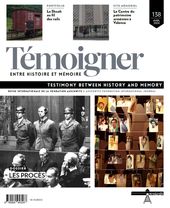
This dossier will deal with trials that have provided a legal answer to a demand for justice. Several cases will be addressed ranging from Istanbul and the Nuremberg Doctors' trial to the German policemen of the Brussels Jewish section and the gacaca trials in Rwanda.
Table of contents (Dutch version)
Table of contents (French version)No. 137 (10/2023) Children's Literature in Light of the Holocaust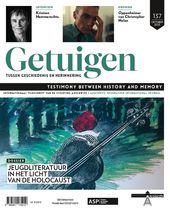
In France and Belgium, research into the relationship between children's literature and the Holocaust is rare, in contrast to the phenomenal attention in America (everyone knows Art Spiegelman's Maus) and in other English-speaking countries. Yet children's books depicting the Holocaust in words and pictures have been steadily gaining ground in post-war France and Belgium. While literary criticism and research still seem to be in their infancy, this dossier will show that critical analysis of this corpus is highly relevant for the future.
Table of contents (Dutch version)
Table of contents (French version)No. 136 (04/2023) The Executioners
The executioner has always fascinated and frightened. The perpetrators of mass crimes are those who carry out, facilitate or order the annihilation of a specific group. Issue 100 of Testimony: Between History and Memory, published in September 2008, examined the Nazi executioners. This dossier offers readers a historical and criminological approach to other genocides of the 20th century.
Table of contents (Dutch version)
Table of contents (French version)No. 135 (10/2022) Disobedience
This issue looks at the concept of disobedience in wartime. While the concept of civil disobedience may seem familiar in these times of endemic protest, there was a time when obedience was the rule. In a military context, disobedience was frequently followed by deadly consequences. This dossier focuses on three cases from the First World War and one from the Algerian War (1954-1962).
Table of contents (Dutch version)
Table of contents (French version)No. 134 (04/2022) The Killing of the ‘Useless’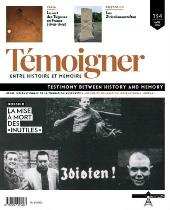
During the Second World War, the Nazi regime didn't just try to destroy the Jewish "race", which it considered dangerous. Before implementing the Final Solution, the Nazis massacred those who didn't fit in with their eugenic racial ideology and whom they considered inferior. In this dossier, we focus on the mentally and physically handicapped, systematic victims of Nazi pseudo-medical madness throughout the world conflict.
Table of contents (Dutch version)
Table of contents (French version)No. 133 (10/2021) 1918-1938: The politicisation of music in Europe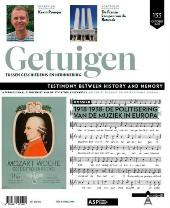
1918-1938: The politicisation of music in Europe
This dossier looks at the instrumentalisation of music by the political world between the wars. The cases are numerous and shed light on the way in which political propaganda was propagated in European musical culture.
Table of contents (Dutch version)
Table of contents (French version)No. 132 (04/2021) AKTION REINHARDT and AKTION ERNTEFEST
AKTION REINHARDT and AKTION ERNTEFEST
The Aktion Reinhardt saw approximately 1.8 million Polish Jews perish in the gas chambers of Bełżec, Sobibór, Treblinka and Majdanek between March 1942 and November 1943. The Jews who ‘escaped’ the gas chambers were shot in Majdanek, Trawniki and Poniatowa on 3 and 4 November 1943 during Aktion Erntefest. The dossier we are proposing takes stock of current research on the Aktion Reinhardt. This historical event has experienced a resurgence of interest among historians of the Shoah over the last fifteen years, thanks, among other things, to archaeological advances at the various sites concerned. We have come a long way since Yithzak Arad's pioneering work in 1987: Belzec, Sobibor, Treblinka: the Operation Reinhard Death Camps. The dossier highlights different perspectives to discuss current research related to the issue. It addresses the erasure of traces, the sociological perspectives of the executioners, the excavation of extermination sites and the most recent historiography.
Table of contents and abstracts (Dutch version)
Table of contents and abstracts (French version)No. 131 (10/2020) Historiography of the Second World War in the Far East
Historiography of the Second World War in the Far East
For many people, 8 May 1945 and the surrender of Nazi Germany is the final chapter of the Second World War. However, it is often forgotten that the months between May and September 1945 were decisive for the future of the world, as fierce fighting continued in the Pacific between the United States and the Japanese Empire until the latter’s unconditional surrender on 2 September 1945, the actual date of the end of the Second World War.Table of contents and abstracts (Dutch version)
Table of contents and abstracts (French version)No. 130 (04/2020) Reception of the Shoah and mentalities in Jewish and Christian circles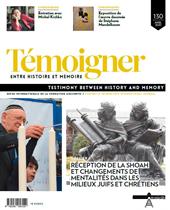
Reception of the Shoah and mentalities in Jewish and Christian circles
The reception of the Shoah has become, for all of humanity, a place of questioning and awareness. This dossier will aim to establish and evaluate the modalities and challenges of the transmission of the Shoah and to measure the resulting changes in identities and mentalities. What were the Catholic views on Judaism before and during the Shoah? What Jewish liturgies and interreligious rites exist for the commemoration of the Shoah in Israel and the United States? The evolution of mentalities in the Jewish world in relation to the Shoah will also be exposed through the analysis of the so-called Bitburg controversy, triggered by the visit of the American President, Ronald Reagan, to the German military cemetery of Bitburg (FRG) in May 1985. The Auschwitz Carmel affair (1985-1993) finally reveals the involvement of the Belgian and French Churches in the resolution of the conflict and is undoubtedly a key stage in the Church's 'teaching of esteem' with regard to the Jews. The historical answers provided in this dossier to the question of the Shoah may be decisive for the survival of Judaism and the relationship between Judaism and Christianity.
Table of contents and abstracts (Dutch version)
Table of contents and abstracts (French version)No. 129 (10/2019) Recognition of victims
Recognition of victims
In recent decades, the idea has gained ground that victims of mass crimes deserve recognition. This has become an essential category of our memorial culture. This dossier aims to take stock of this issue by looking at the broad spectrum of measures to ensure recognition, from simple remembrance to targeted judicial interventions, and by recalling the growing importance of the victim in international criminal justice. It returns to the problematic aspects of recognition when it leads to competition among victims.
Table of contents and abstracts (Dutch version)
Table of contents and abstracts (French version)No. 128 (04/2019) 25 years on, how to remember the Tutsi genocide
Kwibuka [Remember]. 25 years on, how to remember the Tutsi genocide
April 1994. Images of mutilated bodies are projected on European screens, originating from Rwanda. 25 years later, we remember.Table of contents and abstracts (Dutch version)
Table of contents and abstracts (French version)No. 127 (10/2018) Perpetuation of violence after 1918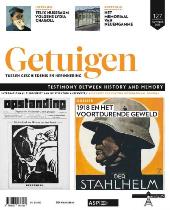
Perpetuation of violence after 1918
One hundred years ago, the First World War ended in November 1918. After four years of bloodshed, peace returns to Europe. At least, that was the impression of the victors at the time, and today it is also the impression of the commemorators who celebrate its centenary. The historical reality is more complex. At least until 1923, violence continued in the form of revolutions and counter-revolutions, wars and civil wars. The spirits also remain in the grip of violence on both the left and the right. The dossier proposes to define the contours of this Europe so strongly marked by the Great War, by evoking the culture of violence established by it and which, finally, degenerated into the total explosion of the Second World War.
No. 126 (04/2018) Questions about the future of remembrance work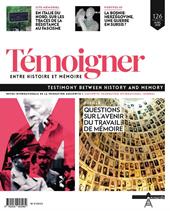
Questions about the future of remembrance work
On 20 and 21 January 2017, the seminar ‘Questions on the future of remembrance work’ was held in Esch-sur-Alzette, Grand Duchy of Luxembourg. The five articles in this dossier taken from the conference proceedings attempt to answer the following questions: How can we build a critical memory of the Shoah, free of myths and national fragmentation? How do we anticipate the absence of direct witnesses? In the future, who transmits what, and how?
No. 125 (10/2017) Persecution of homosexuals by the Nazis
Persecution of homosexuals by the Nazis
Historical knowledge of the Nazi persecution of homosexuals and their deportation has made significant progress in recent years due to the increase in research on the subject. In this dossier, recognised researchers as well as young doctoral and PhD students take the floor. The insights they provide concern both the question of the singular destiny of homosexual men and women during the Second World War and the way in which the memory of the homosexual victims of Nazism has evolved since the end of that war.
No. 124 (04/2017) Music in the camps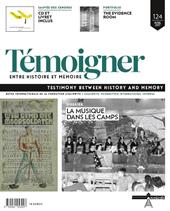
Music in the camps
Music was an integral part of the concentration camp world, Nazi and otherwise. What kind of music was composed and performed, and what exactly was its role in the camps? A factor of survival and resistance for the prisoners, a way for them to express their hope and their humanity - or, on the contrary, an instrument of oppression exploited by the executioners? What is the function of music in the work of memory following the experience of extreme violence and suffering? This dossier proposes to explore these issues.
No. 123 (10/2016) Translating Memory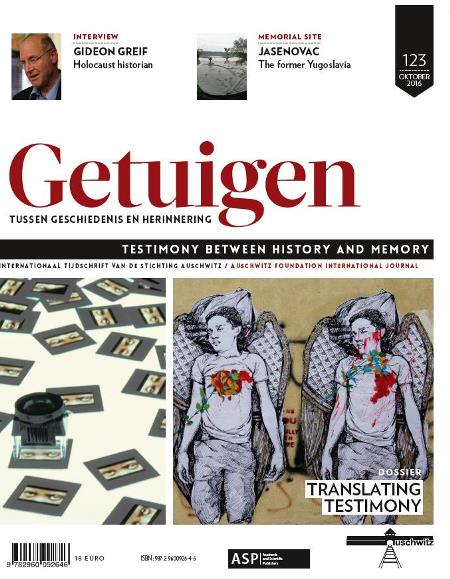
Translating Memory
Presentation of the dossier: What is the relationship between testimony, defined as a more or less ritualized firstperson account of political violence, and translation? Correspondingly, how does the translator position herself towards the witness? Can the translator be, or become, a witness? How, when and why are testimonies translated? Which linguistic and discursive strategies do translators resort to when faced with ethically challenging texts? Which role do they play exactly in the transmission of the historical knowledge, cultural values or social critique conveyed by the testimony? Does translation weaken or rather reinforce the relevance and impact of the original statement? How important is translation in literary, political and institutional settings? Do these specific settings determine translation practice in significant ways? To which extent can subsequent processes of transcription, editing, translation and archiving affect the source text? And how accurate are the boundaries we draw to distinguish witnessing from translating, documentary from literary testimony, the original from its translation? These are the main questions we intend to explore in our dossier.
No. 122 (04/2016) Revisionism and negationism
Revisionism and negationism
Strictly speaking, Holocaust denial is the ‘doctrine denying the reality of the Nazi genocide of the Jews, including the existence of the gas chambers’; by extension, the term refers to the denial of other genocides and crimes against humanity. The literature on Holocaust denial is extensive. There are studies on the subject in many countries as well as biographies of deniers. The argumentative and rhetorical strategies of the deniers have been widely deciphered. Websites systematically dismantle their fallacies. While there is no shortage of reliable information on the phenomenon, it is essential to return to it again and again, for several reasons.
No. 121 (10/2015) Extreme violence on stage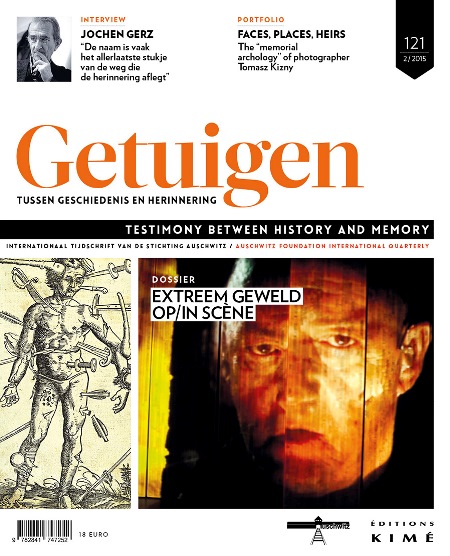
Extreme violence on stage
Extreme violence shows itself. It bursts through the screens. It surfs from one style and medium to another: news reports, documentaries, fiction, arts of all kinds. Yet theatre distinguishes itself from this mêlée all while constantly returning to the subject. Differently. Linked from its origins to the representation of cruelty and having “miraculously” escaped the often sterile polemics on the interdiction (or not)... of representing the Holocaust, it is still with the same youthfulness that theatre deals with extreme violence today, relentlessly pursuing the articulation of ethics and aesthetics.
No. 120 (04/2015) What future is there for the memory of the Armenian genocide?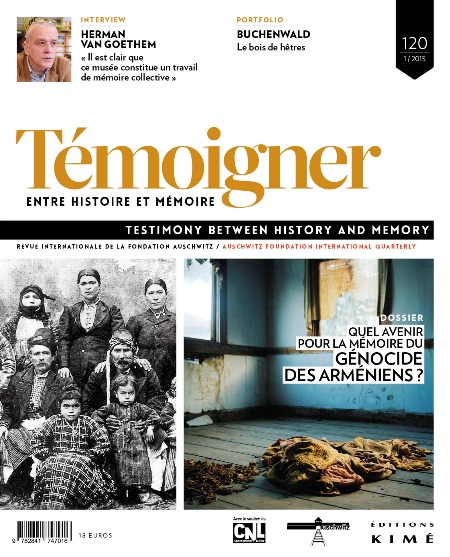
What future is there for the memory of the Armenian genocide?
The 1915 genocide of Turkish Armenians still stirs up numerous debates, controversies, declarations of principle, statements and counter-statements, and even negation. However, as we speak, ties are being established more and more openly, bridges are built and bonds strengthened between the Armenian and Turkish communities. Is reconciliation possible?
No. 119 (12/2014) 70 years ago, Auschwitz. Looking back on Primo Levi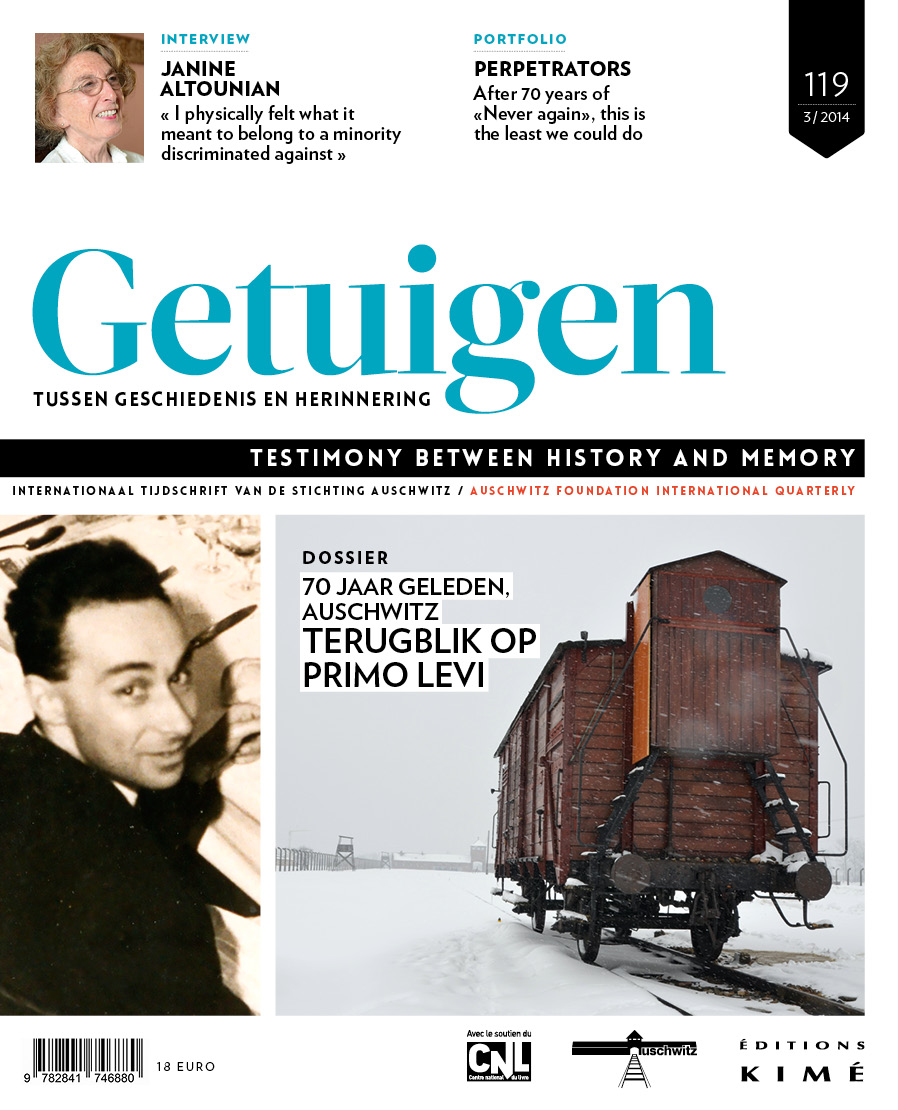
70 years ago, Auschwitz. Looking back on Primo Levi
27 January 1945. Seventy years ago the first soldiers of the Red Army marched into Auschwitz. One might argue that the camp was “liberated” then, but the truth is that neither Auschwitz, nor any of the other Nazi camps, was ever a priority to the Allied Powers. Primo Levi was one of the few survivors who knew how to hide and escape the enforced evacuation of the camps. With this dossier, we want to cast light on the complex figure that Levi was: a Jew, a deportee, a chemists, a witness, and a writer. It sets out to study his oeuvre and his interpretation of the notions of “resistance” and “engagement”, in order to understand how he eventually became a “professional survivor”, as he once described himself.
No. 118 (09/2014) Dictatorship and terror in Argentina, Chile and Uruguay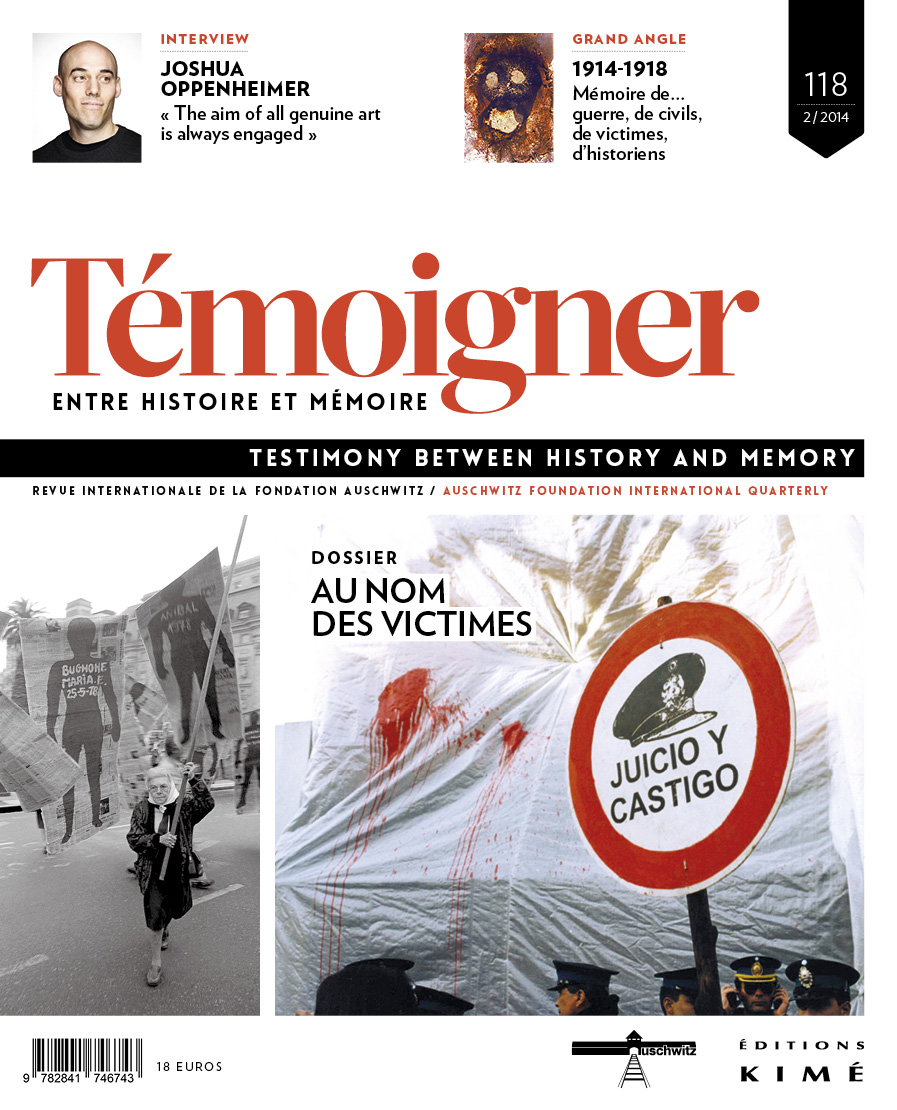
In the name of the victims. Dictatorship and State terror in Argentina, Chile and Uruguay
During the 1970s and 1980s, Argentina, Chile and Uruguay were in the grip of military dictatorships. The process of democratic transition that followed the long period of state terror involved the construction of particular narratives and memories, leading to a reconfiguration of the past. Despite local differences, this process is very much centered at the figure of the victim – a figure the articles in this dossier, collected by Claudia Feld, Luciana Messina and Nadia Tahir, set out to explore.
No. 117 (03/2014) Friends? Enemies? Relationships between memoriesAmis ? Ennemis ? Relations entre mémoires / Vriend of vijand? Hoe herinneringen zich tot elkaar verhouden [Friends? Enemies? Relationships between memories]
Much has been said and written about group memories, limiting their mutual relationships and history to conflicts, “wars”, competitions, or strategies for eclipsing or silencing. These terms have now become the platitudes of a kind of more general doxa about collective and cultural remembrance. This dossier proposes a critical reading of those terms and of that doxa by questioning the emergence, constitution, and inter-relating of different exemplary memories of the major violent episodes of the 20th century. It will address the relationships that those memories can maintain with other memories with which they share, if not the same event, at least similar characteristics and concerns.
No. 116 (09/2013) Memory tripsVoyages mémoriels / Herdenkingsreizen [Memory trips]
Should we fear what has been grouped under the term “memorial tourism”? Or should we take this as a reality of our time? Can any visitor, group or individual, nowadays be absorbed in the category of “tourist”? Or is this category a remote intellectual reduction of a personal experience that everyone is aiming during his visit? The problem appears in a somewhat different light when we think of tours for young people supervised by adults, usually teachers. This dossier gives the floor to historians and teachers with experience in the field.
No. 115 (03/2013) Memory construction in SpainL’Espagne en construction mémorielle / Spanje en de opbouw van de gedachtenis [Memory construction in Spain]
This dossier’s objective is to provide a benchmark for understanding the plural identities and relationships between memories and representation forms in contemporary Spain. Indeed, it is necessary today to take a fresh look not only on the stratified memories of the civil war, exile and the Franco repression, but also on the reception of other memories such as that of the Holocaust, and to propose new readings. We propose to highlight the conflicting or fruitful tensions between official actions, initiatives of associations and of artistic events.
No. 114 (12/2012) Memorial SitesSites mémoriels / Gedenkplaatsen [Memorial Sites]
Memorial sites constitute the concrete trace of European remembrance and history of the twentieth century. But what do they look like today? Exhibition and conservation criteria have changed during the last ten to fifteen years, like advances in historical research have changed the way we read and reconstruct past events. This is not only due to the fact that we have moved from a past history written by witnesses to a history written by professional historians. A new consciousness has emerged concerning transmission methods (memory education), and archeology has strengthened historical research. We tore off the veil of ideology that often influenced and prescribed the way we imagined permanent exhibitions, conservation and visits. Can we say we have entered a new era in memory transmission? It remains, in many ways, an open bet on the present and the future.
No. 113 (09/2012) The Taboos of German HistoryLes tabous de l'histoire allemande / De taboes van de Duitse geschiedenis The Taboos of German History]
The most painful or ambiguous periods in twentieth-century German history are characterized by numerous taboos, expressed in literature, photography and film as so many “returns of the repressed”. These studies focus in part on problems of antisemitism, and thus on the relationship of German-speaking societies to the Shoah. They also examine the way in which those societies confronted the violence they suffered, such as bombing, fleeing from the Red Army and the expulsions, and mass rapes.
No. 112 (06/2012) Children of the Spanish Civil WarLes enfants de la Guerre d'Espagne. Expériences et représentations culturelles / De kinderen van de Spaanse Burgeroorlog. Ervaringen en culturele voorstellingen [Children of the Spanish Civil War: Experiences and Cultural Representations]
The dossier in this issue deals with the experiences and cultural representations of childhood during the Spanish Civil War. It aims to help towards a better understanding of that conflict, which tore apart a population living on the same territory, by confronting the experiences of Spanish children who lived through it – as expressed in various forms during or after the war – with representations of those same children, particularly those coming from adults.
No. 111 (12/ 2011) Dangerous Game between Art and PropagandaArt & propagande : jeux inter-dits / Gevaarlijk spel tussen kunst en propaganda [Dangerous Game between Art and Propaganda]
Since the media came into existence, political institutions from political parties to governments have used them to promote their image, in order to win the support of the public they addressed. Authoritarian powers use the media as a means of consolidating their domination. But how can artists take part in propaganda, whose purposes are the opposite of those generally attributed to art? Does that mean setting aside their vocation, or do they themselves distort that vocation?
No. 110 (10/2011) Displacements, Deportations, ExileDéplacements, déportations, exils / Volksverhuizingen, deportaties, verbanningen [Displacements, Deportations, Exile]
States and criminal groups exploit population displacements to isolate or get rid of certain populations. In addition to being denied their normal rights, these populations lose visibility and are deprived of their reference points and social frameworks. In this way it is possible to make them the victims of constraints (deterritorialization, forced labor…) or violence (famine, massacres genocide…). These developments have spread on an unprecedented scale since the First World War and continue to grow worldwide. But there is also a dimension of remembrance to this reality: memories of these displacements are now being expressed in literature, and in exhibitions and museums. This dossier examines the contemporary double aspect of history and memory.
No. 109 (03/ 2011) 20th Century Wars and Genocides in Graphic Novels and Comic StripsLa bande dessinée dans l'orbe des guerres et des génocides du XXe siècle / Twintigste-eeuwse oorlogen en genociden in het stripverhaal [Twentieth Century Wars and Genocides as Portrayed in Graphic Novels and Comic Strips]
No. 108 (09/2010) How Documentaries Handle HistoryLe traitement de l'histoire dans les documentaires filmiques / De behandeling van de geschiedenis in de documentaire film [How Documentaries Handle History]
No. 104 (09/2009) Anti-fascism Revisited: History, Ideology, RemembranceL'Antifascisme revisité. Histoire – Idéologie – Mémoire / Nogmaals antifascisme. Geschiedenis, ideologie, gedachtenis [Anti-fascism Revisited: History, Ideology, Remembrance]
No. 103 (06/ 2009) Nazi Crimes and Genocides on the ScreenCrimes et génocides nazis à l'écran / Nazimisdaden en genociden op het scherm [Nazi Crimes and Genocides on the Screen]
No. 102 (03/ 2009) The Portrayal of Political Criminals in Films, Plays, Literature...Criminels politiques en représentation. Arts, cinéma, théâtre, littérature, médias / De representatie van politieke misdadigers. Kunst, film, theater, literatuur, media [The Portrayal of Political Criminals in Films and Plays, in Literature and in the Media]
No. 101 (12/2008) How to Educate, How to Remember?Quelle pédagogie, pour quelle(s) mémoire(s) ? / Welke pedagogie, voor welke herinnering(en)? [How to Educate, How to Remember?]
No. 100 (09/2008) Questions about the “Executioners”Questions de « bourreaux » / De kwestie van de “beul” [Questions about the “Executioners”]
Contact
Auschwitz Foundation – Remembrance of Auschwitz
Rue aux Laines 17 box 50 – B-1000 Brussels +32 (0)2 512 79 98
+32 (0)2 512 79 98 info@auschwitz.be
info@auschwitz.be
BCE/KBO Auschwitz Foundation: 0876787354
BCE/KBO Remembrance of Auschwitz: 0420667323
Office open from Monday to Friday 9:30am to 4:30pm.
Visit only by appointment.![]()
![]()
![]()
![]()
Become a member
To become a member of Remembrance of Auschwitz ASBL, take part in its activities and support its actions, please contact us.
Membership costs €40.00, payable to account n° 310-0780517-44 (IBAN : BE55 3100 7805 1744 – BIC : BBRUBEBB)
Donations of more than €40.00 qualify for a tax exemption for Belgian tax-payers.








































